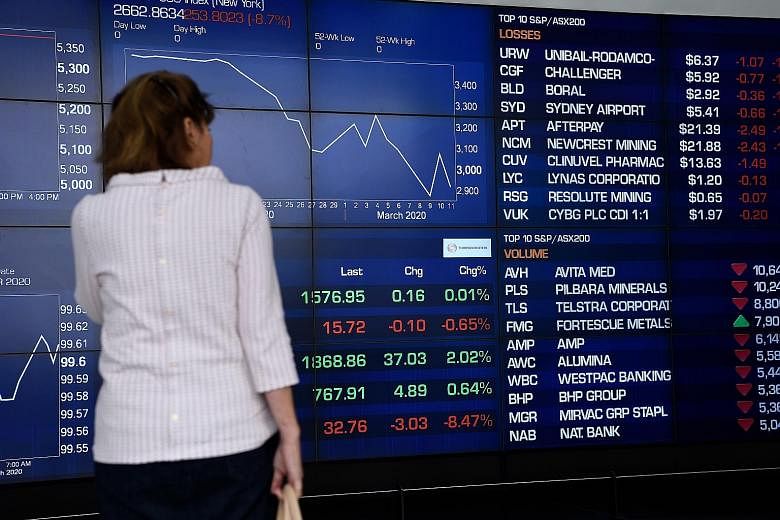The Australian dollar was ravaged yesterday after toppling to 17-year lows as fears of a coronavirus-induced global recession sent investors fleeing from risk assets and commodities, with panic selling even spilling over into sovereign bonds.
The New Zealand dollar was also on the ropes at US$0.5954, having shed 1.7 per cent overnight to the lowest since mid-2009.
In South-east Asia, the Indonesian rupiah has been in free-fall, defying the central bank's intense market intervention as the currency weakened past 15,000 rupiah to a dollar for the first time since the emerging-market rout in 2018.
The decline may now gather further pace as demand for dollars climbs from companies, with the premium for getting dollars against several of the world's major currencies exploding amid concerns over liquidity.
The Australian dollar was pinned at US$0.6004 after sliding 2 per cent on Tuesday to US$0.5958, depths not seen since early 2003.
Against the Singapore dollar, the Aussie was trading at S$0.8519 as of 7.20pm in Singapore, down 0.71 per cent from Tuesday's close. The Aussie has weakened by about 9 per cent to the Singdollar since the start of the year.
Against the US dollar, the Aussie's break below the 2008 low of US$0.6007 reinforced the bleak outlook with the Aussie having lost almost seven cents in less than two weeks.
"Our fair-value model of the Aussie that includes relative interest rates, commodities and risk suggests it should be at US$0.5700, so there's more room yet," said head of forex strategy Ray Attrill at NAB.
"The latest weakness also has to be seen in the context of broad-based US dollar strength, with the dollar index back perilously close to its 99.91 February high."
The US currency was lifted by an outsized increase in Treasury yields, which saw 10-year yields surge 30 basis points in just one session.
Yesterday, lenders from the euro zone borrowed the bulk of the money made available by the Fed - US$112 billion (S$161 billion) in operations coordinated by the European Central Bank - in the biggest use of the crisis-era swap lines since the global financial crisis.
South Korea yesterday also said it would relax a key foreign exchange regulation to spur banks to supply more dollars in local markets.
Meanwhile, the Indonesian rupiah has gone from being Asia's best-performing currency in January to the worst in the past month as a global sell-off sparked by coronavirus concerns deepened.
The rupiah fell as much as 0.3 per cent to 15,224 to a dollar yesterday, extending losses this year to almost 9 per cent.
With foreign investors adopting a flight-to-quality approach, even the high real returns on Indonesian sovereign bonds will not be enough to stop the rush to exit, according to head of treasury I Made Budhi Purnama Artha at Maybank Indonesia in Jakarta.
Bank Indonesia should pump in more dollars to prevent the rupiah from declining further and protect investor confidence, he said.
China's yuan weakened yesterday as well after the People's Bank of China (PBOC) guided the currency lower through its daily fixing.
Before the market open, the PBOC set the midpoint rate of the yuan's daily trading band at 7.0328 per US dollar. It was the weakest such fixing for the currency since Dec 11 last year.
"Investors are digesting the fact that everyone needs dollars in turbulent times," said a trader at a bank in Shanghai. He added that a rush of stop-loss orders on Tuesday had caused some tightness in dollar funding onshore.
REUTERS, BLOOMBERG
- With additional information from The Straits Times

